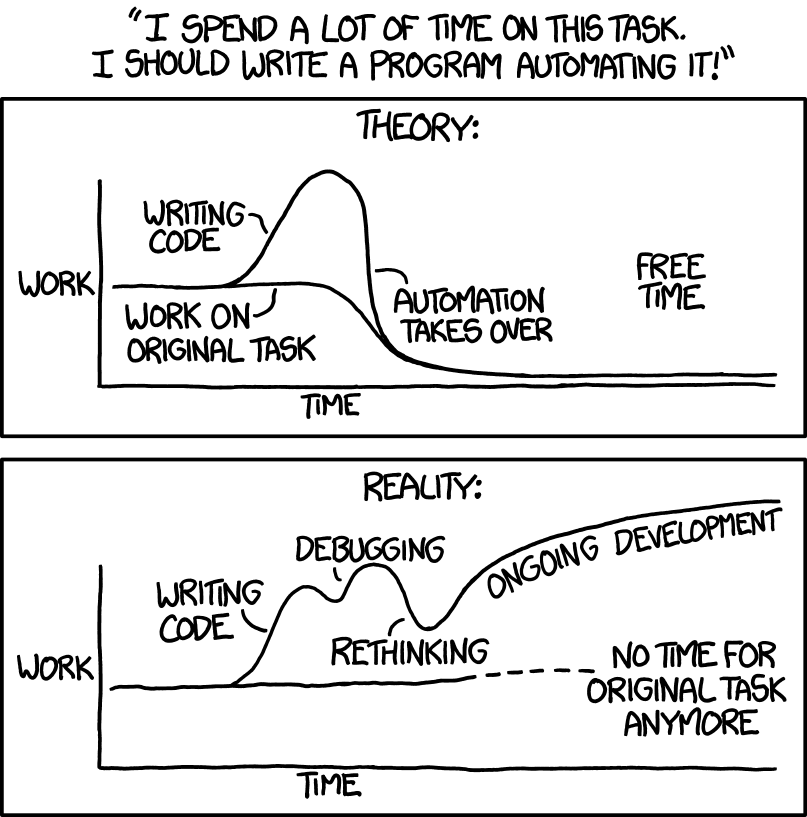This is not that log.
This log's goal is to maybe learn a tiny bit more Spanish. Sometime in the next, oh, 30 years. I intend to go about this in the absolutely worst way possible, which is inspired by these xkcd cartoons:


Instead of, oh, studying, I will build tools to help me study. Instead of sticking with the project consistently, I will likely completely forget the project for years at a time. Do not be like me.
The story up until now. My previous work on Spanish was inspired by Sprachprofi, and it involved audio flash cards and writing substudy. This worked out surprisingly well:
emk wrote:Next Tuesday will be the 60-day mark for this experiment! My deck now contains 437 mature and 263 recent cards (and 271 suspended). I've done 20 hours of Anki reviews, and 3,483 reps. I've learned 3 episodes of Avatar.
While waiting for some software to recompile, I watched parts of two more episodes, all without subtitles. Here are the results:
Episode 5 (above, studied using subs2srs). Comprehension is very high—about where I was after several seasons of Buffy, and after passing my B2 exam. This is pretty remarkable, when you think about it—subs2srs has allowed me to actually "learn" three episodes to the point where I have essentially B2 comprehension. But only for those three episodes.
Episode 6 (prepared for subs2srs, but not yet studied). This case is a bit more interesting. I've recently watched this episode and spent some time aligning the subtitles against the Spanish audio. So I have a pretty good idea what's going on. Overall, this gives a nice boost, especially in the scenes I've watched several times. I can follow the plot, and I can sometimes get big sections of the dialog.
Episode 7 (watched in French about a year ago). This is the purest test of comprehension. I remember the plot of this episode (more or less), but I've forgotten all the details. And I have good news: I can follow most of what's going on! I'm definitely missing over half the dialog, but I almost always get at least several words per sentence, and sometimes I get multiple consecutive lines. Overall, this is actually pretty fun.
[...image lost to history...]
So it looks like I'm definitely nearing the point where I could start just watching Avatar for fun. Even with my strong background in French, this is pretty awesome—20 hours of "official" reviews, according to AnkiDroid, and I'm more-or-less able to follow an actual TV series (with lots of guesswork). (For comparison's sake, Sprachprofi was watching a Japanese TV series unaided after ~30 hours of Anki, with 50% comprehension, but she's a talented polyglot.)
Personally, I'm just happy that my brain is starting to understand things like hay que hacerlo automatically. My English-and-French discount doesn't actually help much with phrases like that, but after 3,483 reps, they tend to jump right out at me.
[...time passes...]
Episodes 11 & 12. Ah, that's better! My comprehension was much better than it was with episodes 9 and 10. To review:
Episode 5 (studied with subs2srs): 80+% comprehension.
Episode 6 (reviewed without subs2srs): Variable, but good overall.
Episodes 7 & 8: Less than 50% comprehension, but I could follow the plot pretty well! Definitely fun.
Episodes 9 & 10: Definitely harder than 7 and 8. Rough going overall.
Episode 11: Not as good as 7&8, but definitely better than 9 and 10.
Episode 12: Wow, this was great! I followed almost all the story, and I understood some sections solidly.
Restarting the project. I have just dug up the hard drive with all my fancy bilingual subtitles, and I am currently rewatching Avatar season 1, episode 1.
The remarkable part is that a half-decade of total neglect of my sub-A1 Spanish, I can actually still understand most of the dialog so far. This is a bit startling—I would expect a sub-A1 language to decay almost totally in 5+ years. But I came very close to memorizing this episode. The lines of dialog are stuck in my head like a song lyric from high school.
I also spent yesterday evening mocking up an SRS UI that does nothing, just to try out some new tools.
Button labels? I am thinking a lot about button labels right now. Anki is designed for learning cards. But when you can create 500 cards with almost zero effort, you want your SRS workflow to change. Any individual card is completely expendable—if you actually need to learn something, you'll see it on another card right away. Instead of failing cards, just review them slightly more often, or throw them out. If a card makes you say, "Ugh," delete it immediately.
In this paradigm, you're not really learning cards. You're "concentrating" them, I guess? You just want to make interesting input reappear more often in the hope that it gets stuck in your head automatically. Less stress, more fun.
Also, I review other people's tools. Some of these are really nice. You should try them, instead of waiting 30 years for me to maybe ship something! (I can actually ship software quickly, if it's putting food on the table! But again, that is not the goal of this project.